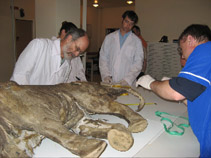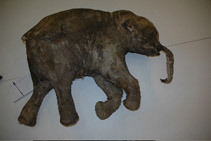July 12, 2007
U-M paleontologist part of international team studying remarkably well-preserved baby Siberian mammoth
 |
| Photo shows U-M paleontologist Daniel Fisher on the left, U-M graduate student Adam Rountrey in the middle and Alexei Tikhonov at right. Credit: Bernard Buigues - Click image for more |
ANN ARBOR, Mich.—University of Michigan paleontologist Daniel Fisher just returned from Siberia where he spent a week as part of a six-member international team that examined the frozen, nearly intact remains of a 4-month-old female woolly mammoth.
Samples will be sent to Fisher's Ann Arbor laboratories for analysis,
he said.
"It's the best and most complete mammoth carcass—baby or adult—ever found," said Fisher, curator of paleontology at the U-M Museum of Paleontology.
 |
| Photo of a remarkably well-preserved baby mammoth -- at least 10,000 years old -- discovered recently in Siberia. Credit: Bernard Buigues - Click image for more |
Fisher has studied elephant-like mammoths and mastodons since 1979 and has worked on more than 20 excavations of the prehistoric pachyderms. But examining the latest Siberian discovery stands out as a career highlight, he said.
"I've studied these animals for so many years and imagined for so long what they must have looked like," Fisher said. "But now, for the first time, I saw one face-to-face in its entirety, and that was a profound experience."
The baby mammoth was discovered by a reindeer herder, Yuri Khudy, in mid-May in western Siberia, after it eroded out of a riverbank. The frozen carcass was taken to a nearby museum, where Fisher, several colleagues, and U-M graduate student Adam Rountrey examined, measured and photographed it.
The baby stood 3 feet tall and measured 52 inches from the base of its trunk to its tail. In its current, partially freeze-dried state, it weighs 110 pounds, including traces of ice and dirt still clinging to the body.
The animal's trunk and eyes and the rest of its external soft tissues are virtually intact, though most of its hair is gone. Its tail and right ear lobe have been chewed off, probably by arctic foxes or other scavengers that fed on the carcass after it eroded from the riverbank, Fisher said.
No tusks are externally visible, but X-rays revealed the presence of nascent tusks—no larger than a human's little finger—as well as molars.
Fisher hopes to bring one of the tiny tusks and one of the molars to his laboratories for analysis, possibly by the end of this year.
Mammoth tusks grew in layers that can be used to age the animal, much like a tree's annual growth rings can be counted to determine its age. But in the case of mammoth tusks, the layers can pinpoint the age to within weeks.
Fisher and Rountrey will also conduct stable-isotope studies on tusk and molar samples to determine the animal's health, the changing fat content of its mother's milk, and variations in local air temperature during its lifetime.
"One of the things we're closing in on and will be able to evaluate further with this specimen is the season of birth of mammoth calves," Fisher said. "We'll also be able to say something more about how fast they grew and how their teeth developed.
"And this is all part of developing a better ability to age these animals and get a better sense of when they matured and when they reproduced," he said.
Contrary to several news reports, the researchers don't yet know how long ago the baby mammoth lived. A small tissue sample has been collected for radiocarbon dating, but right now all the researchers can say is that it lived some time before about 10,000 years ago, when most mainland mammoths went extinct, Fisher said.
A CT-scan will be conducted in Japan, then a dissection will be performed in St. Petersburg, he said.
Related Links:
University of Michigan Museum of Paleontology
Contact: Jim Erickson
Phone: (734) 647-1842
Related Categories: Science
Related Keywords: mammoth
|



